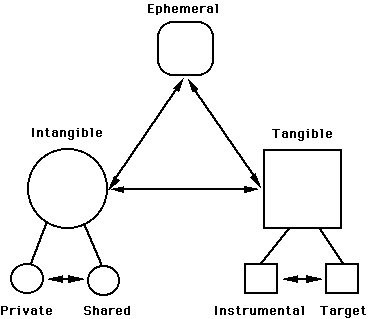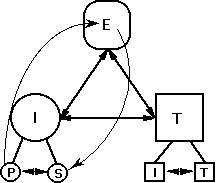
The three projects described previously are quite different from one another in terms of scale, duration, task, and the intellectual activities they used to accomplish their respective goals. But if we focus on the types of information they used and produced, we can also see similarities.
Each of the three groups was concerned with producing some type of tangible product that represented successful completion of the group's primary goal. In Scenario 1, this target product was the brief written recommendation regarding parking policy they wrote during their final meeting. In Scenario 2, it was the 15-page written testimony statement that was included in the record of the Congressional hearing and the two supporting poster boards referred to by the witness in her oral statement. In Scenario 3, the target product was the computer system defined by the source code and the supporting documents, such as the user documentation, delivered with that system.
However, target products tell only part of the story. The groups also produced instrumental products to help them with their task. These ranged from meeting notes and whiteboard jottings, to plans and outlines for the target product, to large independent documents, such as requirements and test plans. Some of these, such as the whiteboard drawings, were ephemeral. They came into existence for a brief time, served their purpose, but were then destroyed or lost. Others, such as the software design documents, were persistent; they were kept by the group and maintained with varying degrees of consistency from the time they were created until the end of the project.
In addition to these tangible forms of information, all three groups also used and/or produced several types of intangible knowledge. Intangible knowledge is carried in the heads of group members. In some cases, it was eventually incorporated into one or more tangible products. For example, in Scenario 1, the organizational change that was finally recommended was first discussed, along with several other possibilities, both inside and outside the group before it was finally encoded into written form. Thus, the information existed in intangible form before it was transformed into a tangible, written document. In other cases, information remained intangible throughout the project. This was true for the options discussed but not selected by the group in Scenario 1.
In some cases, intangible knowledge is shared by the group as a whole. For example, during early group discussion, individual members often voice their different understandings of the group's goal before the group eventually settles on a common approximation acceptable and known to all members. However, not all shared knowledge is developed through explicit group activities; for example, shared knowledge is also carried in the culture of the organization. In Scenario 2, all members of the group knew the general format of a Congressional hearing; what was not common knowledge were the idiosyncrasies of the individual Congress members on the committee.
In other cases, intangible knowledge remains limited to a specific individual or a subset of individuals and, thus, is private with respect to the group as a whole. This is frequently the case when members are selected because they have particular expertise or perspectives. During discussions, some of an individual's private knowledge may become shared as that person speaks to issues from his or her base of private knowledge, but much of this base remains out of sight from the group as a whole and comes into play only indirectly by informing that individual's work or views.

Fig. 2.1. Types of information produced by collaborative groups
and the transformations from one type to another.
Thus, collaborative groups as a matter of course develop three basic types of information: tangible, intangible, and ephemeral. Tangible knowledge can be divided into target products that represent successful completion of the group's task and instrumental products that support the group's work on the target product but are not part of that product. The collection of target and instrumental products developed and maintained by a group during a project constitutes the group's artifact. Intangible knowledge does not take tangible form but, rather, remains within the heads of the members of the group. Some is shared to an approximation by all members of the group; other is private with respect to an individual or a subset of the group. Ephemeral products lie somewhere between tangible and intangible knowledge. This information is given physical form for brief periods of time, but unlike the instrumental products that are included within the artifact, ephemeral products are destroyed or lost. These three basic types of information and their respective subtypes are shown in Fig. 2.1.
The collaborative process produces a flow of information, as information in one form is transformed into information in a different form. This flow is indicated in Fig. 2.1 by arrows between information types. For example, during group discussions, private knowledge held by one member may become shared knowledge held by the group if that person explains a privately held concept to the group. When this happens, information can be viewed as flowing from one individual to the group. If the individual with the private knowledge uses the whiteboard to draw a diagram to help explain the concept, the information is transformed from private to ephemeral to shared knowledge; Fig. 2.2 shows this particular flow. There are a number of different flows that can be observed in groups, produced by a variety of different processes and activities. It remains a task for research to uncover these.

Fig. 2.2. Flow of information from private to ephemeral to shared.
Collaborative groups produce a mix of products and knowledge, but different groups go about it in different ways, on different scales, in accord with different strategies. Consequently, groups can be characterized according to the nature of the artifact and the flow of information from one type to another they produce over the course of a project. To see this, let's look back briefly at the three scenarios from the perspective of the information flow model.
In the first scenario, most of the group's time and effort was spent building a body of shared intangible knowledge, that is, analyzing the parking problem from the perspectives of the different constituencies and finding a solution acceptable to both the members of the group as well as those they represented. The actual target product consisted of only a short three-paragraph statement written at the very end of the project. Ephemeral products were also minimal and the group produced no instrumental products.
In the second scenario, the target product - the 15-page testimony statement and the two accompanying poster boards - was much more substantial, and direct work on it constituted a much larger proportion of the group's effort. This group also produced several different instrumental products - for example, meeting notes and the statement plan - that played important roles in the project. Scenario 2 undoubtedly developed a much larger body of shared knowledge than did the Scenario 1 group; however, this difference is unlikely to be proportional to the difference in size of their respective target products, which had an approximately 20:1 ratio. On the other hand, private knowledge played a much more important role in Scenario 2, because individuals and two-person teams, drawing largely on their individual areas of expertise, developed the detailed plans for the different sections of the statement and then wrote those sections.
The Scenario 2 group also went through a number of shifts between private and group work. This strategy permitted work to go on in parallel; but it also created problems of consistency, for example, when the group integrated the different parts of their detailed plan and, later, when they merged the draft sections of the testimony statement. However, because the scale of the project was relatively modest, resolving these inconsistencies was not particularly difficult or time-consuming.
The Scenario 3 project was several orders of magnitude larger and more complex than the Scenario 2 project. Its target product - the computer system - was a large "document" consisting of more than 1,000 pages of source code and accompanying comments. Instrumental products included a number of complete documents. The body of intangible knowledge shared by the group as a whole included knowledge of project goals, the large-scale architecture of the system, basic principles of object-oriented design, and a new programming language most team members learned at the beginning of the project. Although the volume of shared knowledge for this project was larger than that of the other two, it was probably not proportionally larger relative to the difference in size of their respective artifacts. On the other hand, private intangible knowledge played a much larger role in Scenario 3 than in the other two scenarios, because individual teams possessed and developed specific technical expertise in their assigned portions of the system design. Finally, ephemeral products played a larger and more important role, particularly during the various design activities of the group.
Consistency requirements were more stringent and more apparent for the software development group. In Scenario 2, consistency relationships existed primarily within a single document, the testimony statement; however, in Scenario 3, consistency relationships also existed between documents, such as between the architecture document and the source code. Because of this and because different components were developed by different teams, keeping the whole artifact consistent was much harder. In fact, the group did not always do this, particularly toward the end of the project. These inconsistencies caused problems for the development group, and they can be expected to cause problems for those who will maintain the system in future years. Thus, as a project grows in size and complexity, maintaining consistency and coherence in the artifact is likely to become increasingly important and increasingly difficult, requiring more and more of a group's resources.
Go to:
previous section -
next section -
table of contents